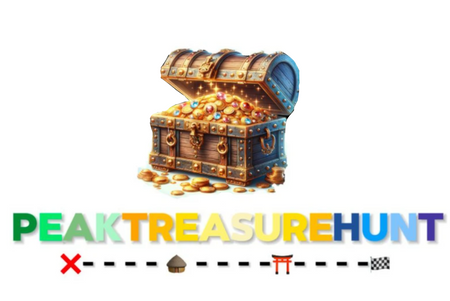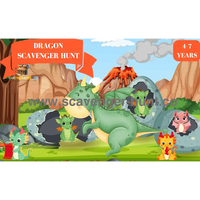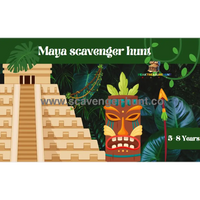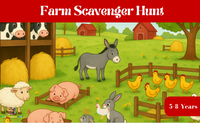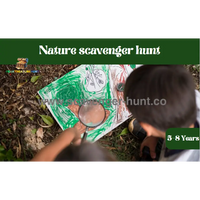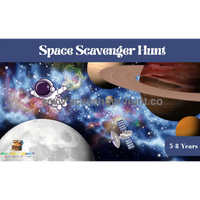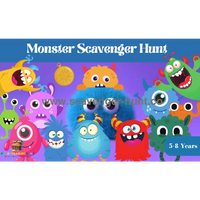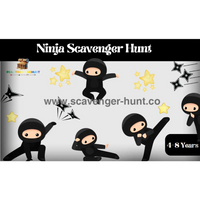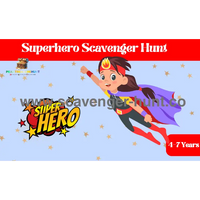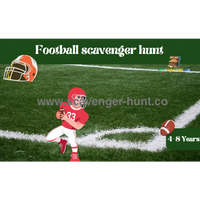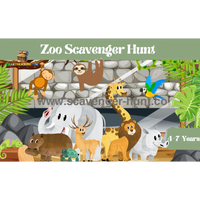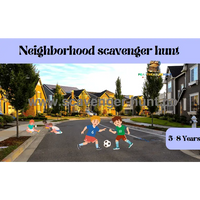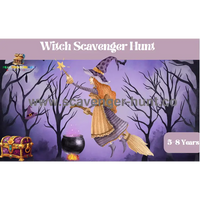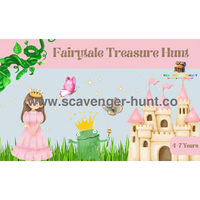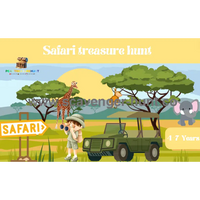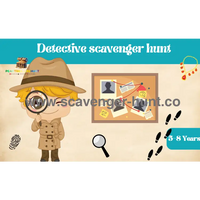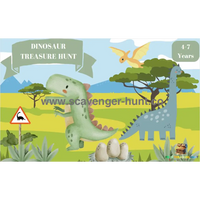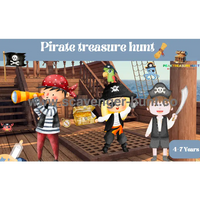🌲Unleashing Fun And Adventure: A Guide To Crafting The Perfect Scavenger Hunt
Scavenger hunts are an exciting and engaging activity that can be enjoyed by people of all ages. Whether you're planning a scavenger hunt for a birthday party, team-building event, or just a fun day out with friends, you likely have questions about how to organize and execute a successful hunt. In this comprehensive guide, we'll answer the top 15 questions people frequently ask about scavenger hunts.

1. What is a scavenger hunt?
A scavenger hunt is a recreational game that adds an element of excitement and adventure to gatherings and events. In this engaging activity, participants are tasked with searching for specific items, solving clues, or completing a list of objectives to achieve a goal. What makes scavenger hunts particularly enjoyable is the blend of problem-solving and exploration that they offer.
The concept of a scavenger hunt dates back centuries and has evolved over time to accommodate various themes and objectives. Whether it's a birthday party, a corporate team-building exercise, a community event, or a fun day out with friends, scavenger hunts have the versatility to suit different occasions.
Participants in a scavenger hunt embark on a journey that takes them to various locations, both familiar and unfamiliar, as they follow clues and instructions. These clues often lead to the discovery of hidden items or landmarks, making the experience a thrilling adventure filled with surprises.
Scavenger hunts can be adapted to suit different age groups and levels of complexity. For young children, a simple hunt for colorful objects in a park can be a delightful activity, while more complex hunts may involve deciphering intricate riddles to reach the ultimate goal.
In addition to being a source of entertainment, scavenger hunts also promote teamwork, communication, and problem-solving skills. They encourage participants to think creatively and collaborate with others to achieve the common objective, making them a valuable activity for team-building exercises or educational purposes.
Whether it's the thrill of the hunt, the satisfaction of solving puzzles, or the joy of discovering hidden treasures, scavenger hunts continue to be a beloved pastime that brings people together and adds an element of adventure to any gathering or event. So, the next time you're looking for a fun and engaging activity, consider organizing or participating in a scavenger hunt for an unforgettable experience.

2. How do I organize a scavenger hunt?
Organizing a scavenger hunt can be an exciting and rewarding experience, but it requires careful planning and execution to ensure that it runs smoothly and is enjoyable for all participants. Below is a step-by-step guide to help you organize a successful scavenger hunt:
Step 1: Define the Theme and Purpose
- Start by determining the theme or objective of your scavenger hunt. Themes can range from birthday celebrations to team-building activities or educational adventures.
- Consider the purpose of the hunt. Is it meant for entertainment, team building, learning, or a combination of these? Understanding the purpose will guide your planning.
Step 2: Set the Date, Time, and Location
- Choose a date and time that works for all participants, and ensure that it fits the theme and purpose of the hunt.
- Select a suitable location or venue for the hunt. It could be a park, a neighborhood, an office building, a museum, or any place that aligns with your theme.
Step 3: Create a List of Items or Clues
- Decide whether your scavenger hunt will involve finding specific items, solving clues, or both. Tailor the list or clues to the age and interests of the participants.
- Be creative when designing your list or clues. You can use riddles, puzzles, or wordplay to add an element of challenge and fun.
Step 4: Prepare Materials and Props
- Gather all the materials and props you'll need for the hunt. This may include printed clues, maps, writing materials, timers, and any special items related to your theme.
- If your hunt has a specific theme, consider incorporating props or decorations to enhance the experience.
Step 5: Determine Rules and Guidelines
- Establish clear rules and guidelines for the scavenger hunt. Outline how teams or individuals will progress, how clues will be solved, and any safety instructions.
- Communicate the rules to all participants before the hunt begins to ensure a fair and enjoyable experience.
Step 6: Form Teams or Assign Roles
- Depending on the number of participants, you can divide them into teams or have individuals participate independently.
- If it's a team-based hunt, assign roles such as a leader, navigator, and clue solver to each team member.
Step 7: Conduct a Test Run
- Before the actual hunt, conduct a test run to ensure that clues are solvable, locations are accessible, and any technical aspects (if applicable) work as intended.
- This will help you identify and address any potential issues in advance.
Step 8: Start the Hunt and Monitor Progress
- On the day of the hunt, gather all participants at the designated starting point, provide them with the initial clue, and start the timer (if applicable).
- As the hunt progresses, monitor the teams' or participants' progress and be ready to provide assistance if needed.
Step 9: Award Prizes
- Once the scavenger hunt is complete, gather all participants for a debriefing and award prizes to the winning team or individual.
- Prizes can be small tokens, certificates, or anything that adds to the excitement of the hunt.
Step 10: Capture Memories
- Encourage participants to take photos or videos during the hunt to capture memorable moments. These can be shared and enjoyed later.
By following these steps, you can organize a fun and memorable scavenger hunt that aligns with your chosen theme and achieves its intended purpose, whether it's for entertainment, team building, learning, or simply a day of adventure and exploration.

3. What are some creative scavenger hunt ideas?
When it comes to organizing a scavenger hunt, creativity knows no bounds. If you're looking to add a unique and exciting twist to your scavenger hunt, here are some creative scavenger hunt ideas and variations to consider:
1. Photo Scavenger Hunt
- Instead of collecting physical items, participants must take photos of specific objects, landmarks, or situations. This adds a creative and visual element to the hunt.
- Examples of photo scavenger hunt items could include a team member doing a handstand in a public place, finding a rainbow, or capturing a stranger's act of kindness.
2. Themed Scavenger Hunt
- Choose a specific theme for your scavenger hunt to make it more engaging and relevant. Themes could revolve around holidays (e.g., Halloween or Christmas), movies, historical eras, or even popular books or TV shows.
- For example, a "Harry Potter" themed hunt might involve finding items related to the wizarding world or solving riddles based on the series.
3. Virtual Scavenger Hunt
- In a virtual scavenger hunt, participants use video conferencing platforms to collaborate and search for items or clues in their own homes.
- You can create a list of items or challenges that participants must complete within a specified time frame, and they can share their findings via video call.
4. Geocaching Scavenger Hunt
- Geocaching combines scavenger hunting with GPS technology. Participants use GPS coordinates to locate hidden containers (geocaches) placed in various outdoor locations around the world.
- Geocaching is a global adventure and can be a thrilling way to explore nature and urban areas.
5. Puzzle Scavenger Hunt
- Incorporate puzzles, ciphers, and codes into your scavenger hunt to challenge participants' problem-solving skills.
- Participants must decipher clues or complete puzzles at each location to uncover the next step of the hunt.
6. Foodie Scavenger Hunt
- For food enthusiasts, create a scavenger hunt that involves sampling specific dishes or snacks at different restaurants or food stalls.
- Participants can rate the dishes and share their culinary experiences along the way.
7. Historical Scavenger Hunt
- Take participants on a journey through history by organizing a scavenger hunt that explores historical landmarks and sites in your area.
- Include interesting facts and trivia about each location to make it educational as well as entertaining.
8. Reverse Scavenger Hunt
- In this twist on the traditional scavenger hunt, participants start with a full bag of items and must strategically distribute or "donate" them to meet specific criteria or challenges.
- The goal is to give away items and reduce the contents of their bags.
9. Nighttime Scavenger Hunt
- Host a scavenger hunt at night using flashlights or glow-in-the-dark clues and items. The darkness adds an element of mystery and adventure.
- Ensure participants have a safe and well-lit path to follow.
10. Costume Scavenger Hunt
- Require participants to wear costumes or dress up as specific characters while completing the hunt.
- This adds a fun and theatrical element to the event, with participants immersing themselves in their chosen roles.
These creative scavenger hunt ideas can add excitement, intrigue, and a unique twist to your next scavenger hunt event. Consider the interests and preferences of your participants when selecting a theme or variation, and don't forget to capture the fun moments along the way!

4. What are the rules for a scavenger hunt?
When organizing a scavenger hunt, it's important to establish clear rules to ensure fairness, safety, and an enjoyable experience for all participants. Here are the essential rules and guidelines for a successful scavenger hunt:
1. Define the Objective:
- Clearly state the objective or goal of the scavenger hunt. Is it a race to find items, solve clues, or complete challenges? Participants should understand what they are trying to achieve.
2. Set Boundaries:
- Specify the boundaries or limits of the hunt. Define the area where participants are allowed to search for items or clues. This could be a specific park, neighborhood, or even a defined indoor space.
3. Teams or Individuals:
- Decide whether participants will hunt individually or in teams. If in teams, specify the maximum team size and encourage teamwork and collaboration.
4. Start and End Times:
- Set start and end times for the scavenger hunt. Punctuality is crucial to ensure a fair competition, especially if there's a time limit.
5. Clue or Item List:
- Provide participants with a list of clues, items, or challenges they need to complete. Ensure that the list is comprehensive and easy to understand.
6. No Trespassing:
- Emphasize that participants must not trespass on private property or enter restricted areas. Respect property boundaries and obtain necessary permissions if required.
7. Safety First:
- Prioritize safety by reminding participants to follow traffic rules when crossing roads, avoid dangerous or prohibited areas, and be aware of their surroundings.
- If the hunt takes place at night, provide guidelines for using flashlights or staying in well-lit areas.
8. Respect for Others:
- Encourage participants to be respectful of others while searching for items. They should not disrupt or inconvenience residents, businesses, or other individuals in the area.
9. No Cheating:
- Strictly prohibit cheating or dishonesty. Participants should not remove or tamper with items that are not part of the hunt, and they should not share answers with others.
10. Reporting and Check-In:
- Establish a system for participants to report their progress or findings. This could include a designated check-in point or a phone/text reporting mechanism.
11. Judging and Prizes:
- If the hunt is competitive, outline how participants will be judged and how winners will be determined. Be transparent about prize distribution.
12. Clean-Up:
- Ensure that participants clean up after themselves. If they need to leave items in their search locations, make it clear that they should not create litter or mess.
13. Have Fun:
- Remind participants that the primary goal is to have fun and enjoy the experience. Encourage sportsmanship and a positive attitude throughout the hunt.
14. Review the Rules:
- Before the scavenger hunt begins, review the rules and guidelines with all participants to ensure everyone is on the same page.
By establishing these rules and guidelines, you can create a safe, fair, and enjoyable scavenger hunt experience for all participants. Clear communication and adherence to these rules will contribute to the success of your event.

5. How can I make a scavenger hunt more challenging?
Making a scavenger hunt more challenging can add excitement and intrigue to the game. Whether you're planning a scavenger hunt for a group of friends, family, or a team-building event, here are some strategies to make it more challenging:
1. Complex Clues:
- Create clues that require more thought and problem-solving. Instead of straightforward clues, incorporate riddles, wordplay, or cryptic hints that participants need to decipher.
2. Time Limits:
- Introduce time limits for completing tasks or finding items. This adds a sense of urgency and encourages participants to strategize their search efficiently.
3. Physical Challenges:
- Incorporate physical challenges or obstacles that participants must overcome to reach a clue or item. This could include physical activities like solving a puzzle, completing a mini-obstacle course, or performing a task at a specific location.
4. Multi-Step Tasks:
- Design clues that lead to a series of tasks or locations, each revealing a piece of the final puzzle. Participants must solve each step to progress.
5. Team Challenges:
- Create challenges that require teamwork and collaboration among participants. They may need to combine clues or work together to access hidden information.
6. Time-Pressure Puzzles:
- Include puzzles with time constraints. For example, participants must complete a jigsaw puzzle within a specified time frame to reveal the next clue.
7. Hidden Codes:
- Use hidden codes or ciphers within clues that participants must decode to proceed. This adds an element of mystery and cryptography to the hunt.
8. Obfuscation:
- Make it more challenging by disguising clues or items in a way that makes them harder to spot. Use camouflage, clever hiding spots, or optical illusions to test participants' observation skills.
9. Scarcity of Resources:
- Introduce scarcity by providing limited resources that participants must use wisely. For example, give them a limited number of photographs to take or a restricted budget for purchasing items.
10. Themed Challenges:
- Incorporate challenges that align with a specific theme or storyline. This adds depth to the hunt and requires participants to immerse themselves in the narrative.
11. Red Herrings:
- Include decoy clues or items (red herrings) that lead participants in the wrong direction. This adds an element of surprise and keeps participants guessing.
12. Require Creativity:
- Ask participants to demonstrate creativity or artistic skills as part of their challenges. This could involve taking creative photographs or crafting something related to the hunt.
13. Environmental Challenges:
- Utilize the environment as part of the challenge. Participants may need to navigate through natural obstacles, like a forest or a beach, to find clues.
14. Limited Clue Access:
- Restrict access to clues or information, requiring participants to solve puzzles or complete tasks to gain access to the next set of clues.
15. Puzzle Complexity:
- Increase the complexity of puzzles used in the hunt. Include math puzzles, logic puzzles, or even ciphers that require in-depth problem-solving.
16. Incorporate Technology:
- Use technology such as QR codes, GPS coordinates, or mobile apps to provide clues or track progress. Participants may need to use smartphones or tablets as part of the challenge.
By incorporating these strategies, you can elevate the level of difficulty in your scavenger hunt, catering to participants who enjoy a more challenging and adventurous experience. Remember to strike a balance between challenge and enjoyment, ensuring that the hunt remains engaging for all involved.

6. What are suitable locations for a scavenger hunt?
Choosing the right location is key to a successful hunt. We'll provide recommendations for various venues, from outdoor parks to indoor settings like malls or office buildings.
Suitable Locations for a Scavenger Hunt
-
Outdoor Parks and Gardens: These natural settings offer expansive spaces and a variety of hidden spots, perfect for a scavenger hunt. Participants can explore among trees, flower beds, and park structures like gazebos or playgrounds. Large public parks often have trails, ponds, and open fields, providing diverse environments for hiding items or clues.
-
Beaches and Lakesides: The sandy shores and nearby areas of a beach or lakeside are great for scavenger hunts. Participants can search around lifeguard stands, under piers, or amongst dunes. The presence of water adds an extra element of fun, allowing for water-based clues or challenges.
-
Urban Areas and City Streets: Urban environments offer a unique scavenger hunt experience with their bustling streets, historic landmarks, and public art installations. Participants can engage with the city's culture while searching for items or solving clues related to local businesses, street art, or historical markers.
-
Museums and Art Galleries: These cultural locations are ideal for an educational and interactive scavenger hunt. Participants can search for clues related to specific art pieces, historical artifacts, or exhibit themes. This setting encourages learning and exploration in a controlled indoor environment.
-
Shopping Malls and Department Stores: Malls provide a vast indoor space with numerous stores, food courts, and common areas. Scavenger hunts here can involve finding items or information related to different shops, brands, or architectural features within the mall.
-
Zoos and Aquariums: These locations combine the thrill of exploring wildlife with the fun of a scavenger hunt. Participants can search for clues related to specific animal habitats, conservation efforts, or educational displays.
-
Historic Sites and Landmarks: Engaging with history, participants can explore castles, forts, old towns, or historical districts. Scavenger hunts in these locations can include clues related to the area's history, architecture, or notable past events.
-
Office Buildings and Corporate Campuses: Ideal for team-building exercises, these locations can host scavenger hunts that encourage participants to explore different departments, interact with colleagues, or discover hidden aspects of their workplace.
-
Theme Parks and Entertainment Complexes: With their various attractions, shows, and themed areas, these locations offer a vibrant and exciting backdrop for scavenger hunts. Participants can search for clues related to specific rides, characters, or themed zones.
-
Libraries and Bookstores: For a more intellectual scavenger hunt, these locations can provide a quiet yet challenging environment. Clues can be hidden in book titles, genres, or related to literary history.
In choosing a location, it’s important to consider the age and interests of participants, accessibility, and safety. Additionally, securing permission from venue authorities and ensuring that the hunt does not disrupt normal operations or other visitors is crucial.

7. What age groups are suitable for scavenger hunts?
Scavenger hunts can be tailored to fit different age ranges. Whether you're organizing a hunt for kids, teens, or adults, we'll guide you on how to adapt the game to suit your participants.
Age Groups Suitable for Scavenger Hunts and How to Tailor the Game
-
Toddlers and Preschoolers (Ages 2-5): At this age, simplicity is key. Scavenger hunts for toddlers should focus on identifying colors, shapes, or familiar objects. The hunt can be set up in a safe, enclosed space like a backyard or a playroom, with items easily visible. Incorporate learning elements, like matching colors or counting items. Adult supervision and guidance are essential.
-
Young Children (Ages 6-9): For this group, scavenger hunts can become slightly more complex. Incorporate basic riddles or puzzles related to the items they need to find. The game can take place in a larger area, like a school ground or a neighborhood park. Themes based on children’s interests, like nature, superheroes, or fairy tales, can make the hunt more engaging.
-
Preteens (Ages 10-12): Preteens enjoy challenges that require more critical thinking. Scavenger hunts for them can involve map reading, solving more complex riddles, or using simple gadgets like compasses. Hunts can be held in community spaces, libraries, or museums, integrating educational elements. Teamwork can be encouraged by forming small groups.
-
Teenagers (Ages 13-17): Teens often seek independence and competition. Scavenger hunts can be designed with a competitive edge, involving time limits or point systems. Utilize technology, like smartphones, for clues or photo tasks. Locations can be more expansive, like a downtown area or a large park. Themes can be aligned with their interests, such as pop culture, technology, or adventure.
-
Young Adults (Ages 18-29): For this age group, scavenger hunts can be sophisticated and socially engaging. Incorporate elements like deciphering codes, GPS-based clues, or city-wide explorations. Themes can be more mature, like historical mysteries, cultural explorations, or even bar crawls with trivia challenges (for those over the legal drinking age).
-
Adults (Ages 30-59): Adult scavenger hunts can focus on team-building, networking, or simply fun and relaxation. Corporate scavenger hunts can include professional development themes. Social hunts might include challenges like cooking, crafting, or historical explorations. The level of physical activity can vary depending on the group's preference.
-
Seniors (Ages 60 and above): Scavenger hunts for seniors should consider mobility and accessibility. These can be held in community centers, gardens, or as part of cultural tours. The focus can be on leisurely exploration, reminiscence, and social interaction, with clues related to history, art, or nature.
For all age groups, safety, accessibility, and the physical and cognitive abilities of participants should be considered. Tailoring the complexity, theme, and physical demands of the scavenger hunt ensures an enjoyable and inclusive experience for all participants.

8. What materials do I need for a scavenger hunt?
Practical materials like lists, clues, props, and prizes are essential for a scavenger hunt. We'll help you compile a comprehensive checklist to ensure you have everything you need.
Materials Needed for a Scavenger Hunt: A Comprehensive Checklist
-
Scavenger Hunt Lists: These are essential and vary depending on the theme and complexity of the hunt. They can range from simple item lists for kids to more complex clues or riddles for adults.
-
Clues and Riddles: For more challenging hunts, prepare clues or riddles that lead participants to the next item or location. These should be age-appropriate and aligned with the hunt’s theme.
-
Maps or Direction Guides: For larger or more complex venues, providing a map or direction guide helps participants navigate the area without getting lost.
-
Props and Decorations: To enhance the theme, use props and decorations at various clue locations. This could be anything from pirate-themed items for a treasure hunt to educational props for a museum hunt.
-
Markers or Signage: These help in indicating clue locations, start and end points, and boundaries for the hunt area. Ensure they are visible and easy to understand.
-
Prizes and Rewards: Having prizes for completion or for finding specific items adds excitement. Prizes should be age-appropriate and can range from small toys or candies for children to gift cards or themed merchandise for adults.
-
Cameras or Smartphones: For hunts involving photo challenges or where participants need to show proof of finding an item, ensure everyone has access to a camera or smartphone.
-
Notebooks and Pens: For hunts that require solving riddles or keeping track of found items, provide notebooks and pens to each participant or team.
-
Bags or Containers: These are useful for participants to collect items, especially in hunts where physical objects need to be gathered.
-
Safety Gear: Depending on the location and nature of the hunt, include items like flashlights, first-aid kits, sunscreen, insect repellent, and water bottles.
-
Timers or Stopwatches: For timed scavenger hunts, have a way to keep track of time, either through smartphones or physical timers.
-
Communication Devices: In large or remote areas, ensure participants have a way to communicate, such as walkie-talkies or cell phones.
-
Waivers or Permission Forms: For public or large-scale events, have waivers or permission forms for participants, especially if minors are involved.
-
Event Sign-in Sheet: For large groups, a sign-in sheet helps keep track of all participants.
-
Instruction Sheets: Provide clear instructions about the rules, objectives, and any safety guidelines of the hunt.
-
Costumes or Themed Attire (Optional): For thematic scavenger hunts, costumes can make the event more engaging and fun.
-
Refreshments: Especially for longer hunts, provide snacks and drinks to keep participants energized and hydrated.
Remember, the key to a successful scavenger hunt is organization. Having all necessary materials prepared and accessible will ensure a smooth and enjoyable experience for all participants.

9. Are there safety considerations for scavenger hunts?
Safety should always be a top priority. We'll discuss safety measures, including participant well-being and respecting the environment and others when conducting scavenger hunts.
Safety Considerations for Scavenger Hunts
-
Pre-Event Planning and Risk Assessment: Carefully plan the hunt, considering potential hazards like traffic, water bodies, or rough terrain. Conduct a risk assessment of the chosen location to identify and mitigate risks.
-
Setting Clear Boundaries: Clearly define the boundaries of the scavenger hunt to prevent participants from wandering into unsafe or off-limits areas. Use maps, physical markers, or digital tools to delineate the area.
-
Participant Briefing: Before starting, brief all participants on the rules, the layout of the hunt, and safety measures. Emphasize the importance of staying within the designated area and respecting private property and the environment.
-
Age-Appropriate Design: Ensure the scavenger hunt is appropriate for the age and abilities of the participants. This includes the complexity of the tasks, the terrain, and the length of the hunt.
-
Supervision for Younger Participants: Provide adequate supervision for children and younger participants. This may involve having adults or guardians as part of the teams or overseeing the event.
-
Communication Plan: Establish a clear communication plan. Provide participants with a way to contact organizers in case of an emergency, such as cell phones or walkie-talkies.
-
First-Aid Availability: Have a first-aid kit accessible and ensure that at least one person present is knowledgeable in basic first aid.
-
Weather Considerations: Check the weather forecast and plan accordingly. Have contingency plans for extreme weather conditions, and ensure participants are dressed appropriately.
-
Hydration and Nutrition: Remind participants to stay hydrated and provide water stations or encourage them to carry water, especially in hot weather. For longer hunts, consider providing snacks or breaks for food.
-
Respect for the Environment: Instruct participants to minimize their impact on the environment. This includes not disturbing wildlife, staying on trails in natural areas, and not littering.
-
Respecting Others: Ensure that the scavenger hunt does not disrupt the normal activities of others who are not participating, especially in public or shared spaces.
-
Traffic and Pedestrian Safety: If the hunt involves crossing streets or navigating through urban areas, remind participants about traffic safety and pedestrian rules.
-
Emergency Procedures: Have an emergency plan in place, including contacts for local emergency services and a procedure for managing any incidents.
-
Participant Health Screening: For physical or outdoor hunts, consider screening participants for health issues that may be exacerbated by the activity.
-
Personal Protective Equipment (PPE): Depending on the location and nature of the hunt, provide or advise participants to bring appropriate PPE, such as gloves, hats, or sunscreen.
By thoroughly considering and addressing these safety aspects, you can ensure that the scavenger hunt is not only fun and engaging but also safe for all participants.

10. Can I do a scavenger hunt indoors or outdoors?
The versatility of scavenger hunts allows you to host them in various settings. We'll explore the possibilities of both indoor and outdoor hunts and offer insights into adapting the game to different environments.
Indoor and Outdoor Scavenger Hunts: Exploring the Possibilities
Scavenger hunts are highly adaptable and can be tailored to suit both indoor and outdoor settings, each offering unique experiences and challenges.
Indoor Scavenger Hunts
-
Home-Based Hunts: Ideal for family activities or parties, scavenger hunts within a home can involve searching for common household items, solving puzzles, or following a story or theme.
-
Office Hunts: Great for team-building, indoor hunts in an office can encourage employees to explore different areas, interact with colleagues, and solve work-related riddles.
-
Schools and Libraries: Educational scavenger hunts can be organized in these spaces, focusing on learning themes like literature, history, or science.
-
Museums and Galleries: These venues offer a unique backdrop for hunts, where participants can learn about art, history, or culture while searching for clues related to exhibits.
-
Shopping Malls: A scavenger hunt in a mall can involve finding items, exploring different stores, or completing tasks related to shopping or food courts.
Outdoor Scavenger Hunts
-
Parks and Gardens: Natural settings are perfect for scavenger hunts, offering wide-open spaces and diverse environments. Hunts can focus on nature, geography, or fitness challenges.
-
Urban and City Hunts: Utilizing the streets and landmarks of a city, these hunts can explore urban landscapes, cultural sites, and historical areas.
-
Beach and Lakeside Hunts: Waterfront settings provide a fun backdrop, where hunts can include searching for natural items, environmental learning, or water-based activities.
-
Adventure and Camping Sites: For a more adventurous hunt, outdoor campsites or adventure parks can offer hunts that include orienteering, survival skills, or physical challenges.
-
Zoo and Botanical Gardens: These venues are ideal for educational and wildlife-themed scavenger hunts, focusing on animal and plant identification, conservation, and ecological awareness.
Adapting the Game to Different Environments
-
Thematic Relevance: Tailor the theme of the scavenger hunt to the setting, whether it’s a historical theme for a museum or a nature theme for a park.
-
Safety Considerations: Ensure the hunt is safe for the chosen environment, providing necessary equipment or safety instructions.
-
Age Appropriateness: Adapt the complexity and physical demands of the hunt to suit the age and abilities of the participants.
-
Use of Technology: Incorporate technology like smartphones or GPS for clues and navigation, especially in larger or more complex environments.
-
Environmental Respect: Ensure the scavenger hunt respects the environment, especially in natural settings, by minimizing disturbance and leaving no trace.
-
Interactive Elements: Include interactive tasks or challenges that engage participants with the surroundings, whether it’s solving a puzzle in a library or identifying a plant species in a park.
Whether indoors or outdoors, scavenger hunts offer versatile, engaging, and customizable experiences suitable for a wide range of participants and settings.

11. What is the scavenger hunt method?
The "scavenger hunt method" refers to the approach or process of conducting a scavenger hunt. Scavenger hunts are recreational activities in which participants search for specific items, solve clues, or complete tasks to achieve a goal. Here's a step-by-step method for organizing and executing a scavenger hunt:
-
Define the Purpose and Theme:
- Determine why you're organizing the scavenger hunt and choose a theme or concept that aligns with the purpose. Themes can add excitement and context to the hunt.
-
Create Clues or Tasks:
- Develop a set of clues, riddles, or tasks that participants must solve or complete to progress in the hunt. Clues should be challenging but solvable, leading participants to the next location or item.
-
Select a Location:
- Choose an appropriate venue for the scavenger hunt based on the theme and the age group of participants. Common locations include parks, beaches, malls, museums, or even your own home.
-
Set Up the Final Treasure or Prize:
- Hide the final treasure or prize in a manner consistent with the theme. Ensure that the prize is worth the effort participants put into the hunt.
-
Gather Participants:
- Invite participants to join the hunt. Clearly communicate the date, time, and meeting point for the event. Teams can be formed if the hunt is competitive.
-
Provide Rules and Instructions:
- Share the rules of the scavenger hunt with participants, including any safety guidelines and the objective of the game. Explain how clues or tasks should be approached and any time limits if applicable.
-
Oversee the Hunt:
- During the hunt, organizers or supervisors should be present to ensure participants are following the rules and to provide assistance if needed.
-
Award Prizes:
- After the hunt, gather participants and announce the winners or acknowledge everyone's efforts. Distribute prizes if applicable.
-
Reflect and Improve:
- After the scavenger hunt, take time to reflect on what went well and what could be improved. Use feedback to enhance future scavenger hunts.
The scavenger hunt method can be adapted and customized to fit various themes, age groups, and objectives. Whether it's a birthday party, team-building exercise, or just a fun activity with friends, the method ensures a well-organized and enjoyable experience for all participants.

12. How do you play scavenger hunt?
Scavenger hunts are a fantastic way to add fun and excitement to any gathering or event. By following the answers to these top 15 questions, you'll be well-prepared to organize a memorable and enjoyable scavenger hunt that will have participants eagerly searching for clues and treasures. So, get ready to embark on a scavenger hunt adventure that will leave everyone thrilled and entertained!
Discover our Complete Scavenger Hunts Collection.

